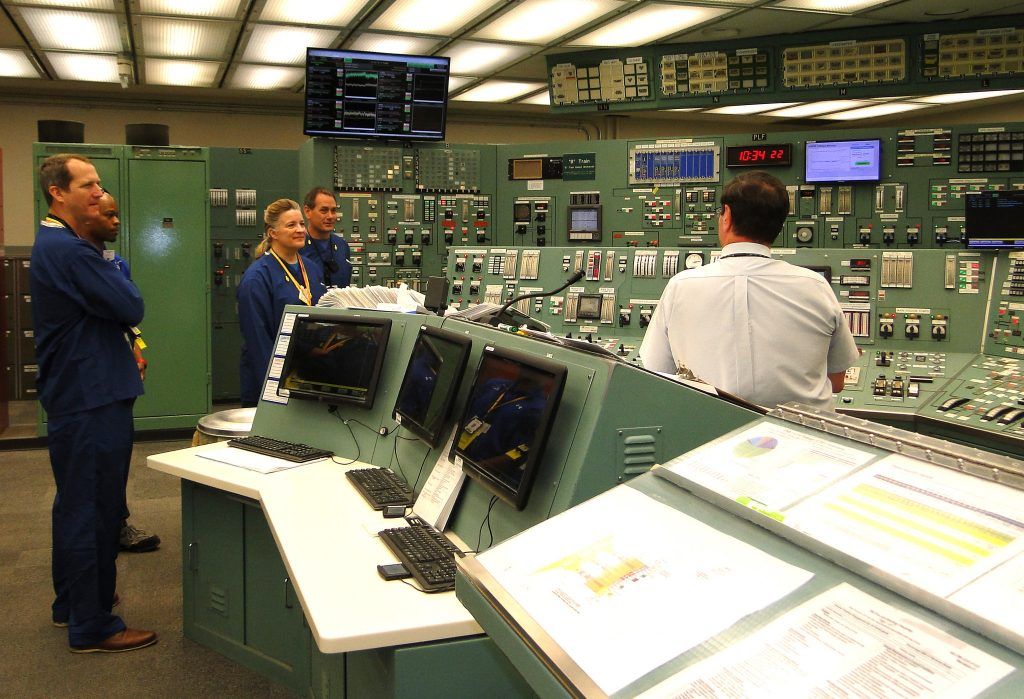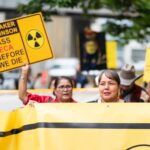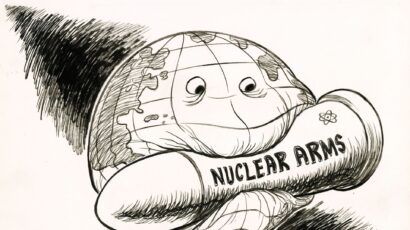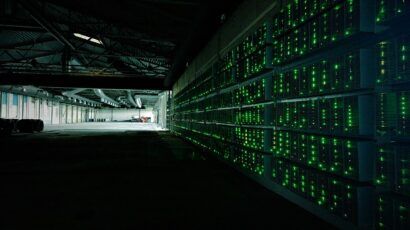Aging nuclear plants, industry cost-cutting, and reduced safety oversight: a dangerous mix
By Edwin Lyman | August 29, 2019
 NRC Commissioner Annie Caputo visits Three Mile Island Nuclear Generating Station, June 2019. Credit: NRC
NRC Commissioner Annie Caputo visits Three Mile Island Nuclear Generating Station, June 2019. Credit: NRC
After the 2011 Fukushima nuclear disaster in Japan, the US Nuclear Regulatory Commission (NRC) set up a task force to assess whether there were deficiencies in its oversight of nuclear reactor safety. The task force came back with twelve major areas for improvement. Its top recommendation: The agency needed to strengthen its fundamental regulatory framework to reduce the risk that a Fukushima-scale accident could happen in the US. But after dragging their feet for years, the NRC commissioners finally rejected the proposal in March 2016, with then-Commissioner William Ostendorff concluding that “the current regulatory approach has served the Commission and the public well.”
Yet only a few years later, the NRC has reversed course. The agency now says it urgently needs to transform its regulatory framework, its culture and its infrastructure—but in ways that would weaken, rather than strengthen, safety and security oversight. A key aspect of that transformation is an overhaul (or what the NRC euphemistically calls an “enhancement”) of the Reactor Oversight Process, the NRC’s highly complex system for determining how it inspects nuclear power reactors, measures performance, assesses the significance of inspection findings, and responds to violations. Overall, these changes—many of which are being pushed by the nuclear industry—could make it harder for the NRC to uncover problems and mandate timely fixes before they jeopardize public health and safety.
Aging nuclear plants need to be watched more closely, not less. The US nuclear power industry is facing major challenges. Stiff competition from low-cost natural gas has placed many plants under financial strain and at risk of early closure. At the same time, the nuclear reactor fleet is getting older. The average age of the 97 operating US power reactors is 38 years, according to the Energy Information Administration, and nearly all have received NRC-approved extensions of their operating licenses from 40 to 60 years. Six reactors have even applied for an additional 20-year extension.
As nuclear reactor age, they require more intensive monitoring and preventive maintenance to operate safely. But reactor owners have not always taken this obligation seriously enough. A 1992 Brookhaven National Lab study found that “while some plant organizations appear to assume a proactive stance in preventing aging-related failures … important to safety, others seem to be taking a passive or reactive stance. Differing maintenance philosophies and financial resources have an impact on plant management’s attention to aging concerns.” To address this problem, the NRC required plants seeking license renewals to develop aging management programs and incorporated aging issues into many of its inspections. Even so, the Brookhaven study’s concerns are more relevant today than ever.
Given that older reactors require more attention from the regulator, not less, it is perplexing that the NRC wants to scale back its inspections of the aging reactor fleet and its responses to safety violations. Six years ago, the US Government Accountability Office pointed out that “NRC’s oversight will soon likely take on even greater importance as many commercial reactors … are reaching or have reached the end of their initial 40-year operating period.” And aging management is far from the only safety program that could be compromised by reactor owners’ cost-cutting without vigilant regulatory oversight.
The impact of less frequent and less intensive inspections is clear: The NRC will have fewer opportunities to catch violators and smaller data sets for assessing reactor safety. If reactor performance were steadily improving, as the nuclear industry argues, such reductions might be appropriate. But key safety and security indicators suggest otherwise.
At a June 2019 meeting, NRC Commissioner Jeff Baran elicited from the staff that the number of sudden reactor shutdowns rose from 39 in 2017 to 46 in 2018, a nearly 20 percent increase. (Since the NRC terminated its Industry Trends Program in 2016, it no longer routinely releases such data.) In 2019, by this author’s count, around 40 such shutdowns had already occurred by late August. At that rate, the number could approach 60 by year’s end—a 25 percent increase over 2018. And this tally doesn’t include six other unscheduled reactor shutdowns so far this year that were necessary for safety reasons.
There are also signs of a similar decline in the ability of reactor security forces to protect their facilities from terrorist attacks that could cause reactor or spent fuel meltdowns and releases of radiation to the environment. In 2018, the NRC found 111 security violations—about the same number as in 2017, despite having conducted 25 percent fewer inspections.
While it is too early to say if these adverse trends are statistically significant, they should at least give the NRC pause before it dials back its inspections and enforcement. But the agency staff doesn’t see a problem, claiming its proposals would result in “an appropriate level of oversight with less regulatory burden and expenditure of resources by focusing oversight on issues of greater safety significance.” While this sounds reasonable on its face, make no mistake—this initiative is primarily about reducing cost to industry, including the fees reactor owners are assessed to pay for NRC inspections. In a March 2019 speech, Commissioner Baran pointed out that the proposal to reduce the frequency of certain inspections from every three to every four years would not improve safety and efficiency, but would simply mean the NRC would be “doing less.”
The Reactor Oversight Process in a nutshell. To appreciate how the proposed Reactor Oversight Process changes could impact reactor safety, one needs to understand a bit about how the highly technical program works.
The process begins with “baseline” inspections that are conducted at all nuclear reactors, regardless of their performance. The inspections are organized into “strategic performance areas” and further subdivided into “cornerstones of safe operation.” If violations are found, they are assigned one of four colors (green, white, yellow, or red), ranging from findings of “very low safety or security significance” (green) to “high safety or security significance” (red). The NRC staff determines the significance of violations with a process that combines calculations and subjective judgments.
Each reactor is also graded with respect to a series of “performance indicators” based on safety statistics such as the rate of unplanned shutdowns. Confusingly, a green performance indicator denotes an “expected” performance level, unlike a green inspection finding, which is a violation.
The result of this inspection and assessment process is the “Action Matrix”: a scorecard that ranks nuclear reactors in one of five categories, ranging from best (Column 1) to worst (Column 5). Each quarter, the position of each plant in the matrix is updated. Plants that end up in Columns 2 and higher are subject to progressively more intensive oversight, including supplemental inspections.
If the nuclear reactor fleet were a class of students and the NRC its teacher, the agency might be suspected of major grade inflation. In the current Action Matrix, reflecting data through the second quarter of 2019, 94 out of 98 reactors were in Column 1, 4 were in Column 2, and none were in the higher columns. If the columns corresponded to letter grades, 96 percent of the reactors would be getting As and 4 percent Bs, akin to the children of Lake Wobegon all being “above average.” However, this is more the result of the low bar for achieving Column 1 status than a sign of stellar safety performance. More than a few reactors now in Column 1 would find themselves with Ds if the NRC graded them on a curve.
This isn’t an accident. When the color ranking system for performance indicators was first set up in the late 1990s, the NRC defined the green band to encompass performance within “the normal range of industry historical performance and risk.” Accordingly, the green/white threshold was set so that “95% of the plants have observed data values that would be in the Green band.” (Like the Yellow Submarine, visitors to the NRC website’s performance indicator page will find themselves in a proverbial “sea of green.”) Thus being green doesn’t denote good performance, but merely adequate compliance— more a “gentleperson’s C” than an A.
The NRC has further muddied the waters by making it harder to move reactors to higher Action Matrix columns as their safety performance deteriorates. For example, initially a reactor receiving two white-level violations in the same cornerstone would be bumped up from Columns 2 to 3. However, in December 2015 (over the objection of Commissioner Baran), the NRC decided to raise the threshold for such a shift from two to three white violations. Under the new rules, a reactor that would have been moved to Column 3 because of two white violations could now remain in Column 2. It would look safer without actually being safer. Changing the ground rules midstream makes it difficult for the public and the NRC alike to discern if nuclear safety is getting better or worse over time.
“Fighting the White.” One consequence of making Column 1 status so easy to achieve is that it looks really bad when a plant gets a single white-level violation or performance indicator and is shifted to Column 2. For that reason, plant owners often vigorously contest proposed white violations—what some call “fighting the white.” The color determinations are subject to dispute because the underlying risk assessments have uncertainties and typically involve the judgment of NRC analysts.
In May 2018, Greg Halnon, chair of the National Regional Utility Group, which represents nuclear plant licensees, sent the NRC a letter on “transforming the Reactor Oversight Process to a new paradigm.” Halnon complained that “any finding of greater than baseline risk (i.e. … white, yellow, or red …) grabs the attention of the public as well as that of politicians and activist groups.” Such findings are “exploited by anti-nuclear activists,” “cause burdensome public relations issues,” and “lead to an erroneous sense of enterprise risk among financial analysts and other observers.” To solve this public relations problem, Halnon suggested that the NRC should “consider eliminating all colors of findings and document only findings that have potential to impact operations.” The letter also recommended that the NRC eliminate one of its inspections and instead give credit to “self-assessments” by licensees—that is, allow reactor owners to conduct some inspections themselves.
Reducing inspections and follow-up. Following Halnon’s letter, the nuclear industry’s chief lobbying organization, the Nuclear Energy Institute, sent the NRC its own wish list of 27 suggestions for “enhancing” the oversight process. These included major changes such as combining Columns 1 and 2 of the Action Matrix, so that white-level findings would no longer trigger a column shift at all (and the value of Column 1 status would be deflated even further).
In November 2018 and July 2019, despite the concerns of some NRC staffers, NRC senior management sent the commissioners its first set of recommendations for Reactor Oversight Process changes. (It has promised that more will follow.) These include reducing the hours and sample sizes of many critical reactor safety inspections, including fire protection. It also recommends reducing the frequencies of other inspections. However, the staff did not include some of the industry’s worst ideas, such as giving licensees more freedom to do self-inspections (perhaps with the recent Boeing 737 MAX 8 fiasco in mind).
The staff did not propose doing away with color findings altogether or combining Columns 1 and 2 of the Action Matrix. However, it did recommend decreasing the time period that greater-than-green violations remain on the books, reducing opportunities for multiple violations to overlap and trigger additional oversight. This change will make it harder for the process to detect and respond to systemic safety issues that may only reveal themselves over time.
Perhaps to dispel the impression that the NRC has been completely captured by the industry, the staff recommended a few changes that the industry doesn’t like. But they are the exceptions that prove the rule.
The NRC staff admits that some of its proposals could make its oversight less effective. It points out that “less inspection may lead to fewer inspection findings,” resulting in “fewer licensees transitioning to higher columns in the Action Matrix,” and that less frequent inspections could allow for “a safety-significant performance deficiency to exist for a longer period before being identified.” Ultimately, “reduced oversight could also result in licensees relaxing standards.”
The staff also acknowledges that the proposed changes to the Action Matrix could “make it more difficult for licensees to move to higher columns,” allowing “performance to decline to a point where increased regulatory oversight is appropriate, but not dictated by the licensee’s position in the Action Matrix.” Nevertheless, the staff reported to the Commission that “the aggregate impact of the proposed changes would result in an improved ROP,” without explaining how reducing the likelihood that the NRC will catch safety problems represents an improvement.
The future. At this time, the four sitting commissioners (there is one vacancy) have not all voted on the proposed reactor oversight changes, but the outcome isn’t in much doubt. The Republican majority, under the direction of Chairman Kristine Svinicki, has already weakened the NRC’s regulatory authority in other areas. For example, in a 3-2 vote in January 2019, the majority gutted the staff’s proposed final rule for protection against Fukushima-scale natural disasters by eliminating the requirement that reactors be able to withstand current flooding and seismic hazards. Ultimately, the commissioners are free to reject the staff’s advice and mandate any change the industry wants, from expanding self-assessments to getting rid of white-level findings altogether.
Without active pushback from Congress and the public, the NRC’s march toward less regulation may be unstoppable. Fortunately, some in Congress have become concerned. Democrats in the House of Representatives sent a letter to the NRC in July 2019 protesting the proposals and requesting a public comment period before the NRC implements them. The NRC complied and initiated a 60-day comment period on August 7, 2019. Although it is under no obligation to accept any of the public comments, the NRC will have to respond to them, justify the proposals further, and explain their impacts more clearly. Hopefully, this additional bit of daylight will help ensure that the NRC has all the tools it needs to protect public health and safety as the reactor fleet enters its not-so-golden years.
Together, we make the world safer.
The Bulletin elevates expert voices above the noise. But as an independent nonprofit organization, our operations depend on the support of readers like you. Help us continue to deliver quality journalism that holds leaders accountable. Your support of our work at any level is important. In return, we promise our coverage will be understandable, influential, vigilant, solution-oriented, and fair-minded. Together we can make a difference.
Keywords: Nuclear Regulatory Commission, nuclear energy, nuclear inspections, nuclear safety, oversight
Topics: Analysis, Nuclear Energy
















The suggestion of grading on a curve rather than meeting set standards where all may be rated “above average” is absurd. This isn’t high school. When standards are met, the grades are given. When a plant is in a lower ranking, it cost the company millions to recover to column 1. This process must be done by comparing against a set standard and not against peer plants where a good plant is punished because they aren’t the best plant.